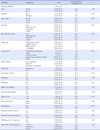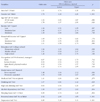Abstract
Purpose
This study was done to investigate the prevalence of suicidal ideation and associated factors in Korean adults.
Methods
From the database of the 5th Korean National Health and Nutritional Examination Survey conducted in 2010, cross-sectional data for 6,283 adults (≥20 years) were used in this analysis.
Results
One-year prevalence of suicidal ideation was 14.8%. Higher suicidal ideation was found for women, elders, adults who were divorced or separated, who were in the lower socio-economic class, were alcohol dependent, had a short sleep time, and had higher perceived stress and depression. On stepwise multivariate logistic regression analysis, depression (odds ratio 6.89 [95% confidence interval 5.18~9.16]), perceived stress(3.52 [2.66~4.65]), being woman (1.72 [1.32~2.26]), being an elder (≥65 yrs) (1.78 [1.07~2.96]), low education(3.52 [2.66~4.62]) and not married (1.48 [1.04~2.12]) were associated with suicidal ideation in Korean adults.
Figures and Tables
References
1. Babor TF, Higgins-Biddle JC, Saunders JB, Monteiro MG. The alcohol use disorders identification test: Guidelines for use in primary care. 2001. Geneva: World Health Organization.
2. Borges G, Nock MK, Haro Abad JM, Hwang I, Sampson NA, Alonso J, et al. Twelve-month prevalence of and risk factors for suicide attempts in the World Health Organization World Mental Health Surveys. J Clin Psychiatry. 2010. 71:1617–1628.

3. Carlson GA, Cantwell DP. Suicidal behavior and depression in children and adolescents. J Am Acad Child Psychiatry. 1982. 21:361–368.

4. Cavanagh JT, Carson AJ, Sharpe M, Lawrie SM. Psychological autopsy studies of suicide: A systematic review. Psychol Med. 2003. 33:395–405.

5. Chin YR, Lee HY, So ES. Suicidal ideation and associated factors by sex in Korean adults: A population-based cross-sectional survey. Int J Public Health. 2011. 56:429–439.

6. Forkmann T, Brahler E, Gauggel S, Glaesmer H. Prevalence of suicidal ideation and related risk factors in the German general population. J Nerv Ment Dis. 2012. 200:401–405.

7. Fujino Y, Mizoue T, Tokui N, Yoshimura T. Prospective cohort study of stress, life satisfaction, self-rated health, insomnia, and suicide death in Japan. Suicide Life Threat Behav. 2005. 35:227–237.

8. Im MY, Kim YJ. A phenomenological study of suicide attempts in elders. J Korean Acad Nurs. 2011. 41:61–71.

10. Jeon HJ, Lee JY, Lee YM, Hong JP, Won SH, Cho SJ, et al. Lifetime prevalence and correlates of suicidal ideation, plan, and single and multiple attempts in a Korean nationwide study. J Nerv Ment Dis. 2010. 198:643–646.

11. Jollant F, Lawrence NL, Olie E, Guillaume S, Courtet P. The suicidal mind and brain: A review of neuropsychological and neuroimaging studies. World J Biol Psychiatry. 2011. 12:319–339.

12. Kim YJ, Kang HJ. Study on variables related to adults' suicidal ideation. J Fam Relat. 2011. 16:45–61.
13. Korea National Statistics Office. Death statistics in 2011. 2012. Daejeon: Korea National Statistical Office.
14. Lee JI, Lee MB, Liao SC, Chang CM, Sung SC, Chiang HC, et al. Prevalence of suicidal ideation and associated risk factors in the general population. J Formos Med Assoc. 2010. 109:138–147.

15. Lee YJ, Kim SJ, Cho IH, Kim JH, Bae SM, Koh SH, et al. A study on the relationship between sleep duration and suicidal idea in an urban area of South Korea. Sleep Med Psychophysiol. 2009. 16:85–90.
16. Linda WP, Marroquin B, Miranda R. Active and passive problem solving as moderators of the relation between negative life event stress and suicidal ideation among suicide attempters and non-attempters. Arch Suicide Res. 2012. 16:183–197.

17. Meltzer H, Bebbington P, Brugha T, Jenkins R, McManus S, Dennis M. Personal debt and suicidal ideation. Psychol Med. 2011. 41:771–778.

18. Ministry of Health and Welfare Korea Center for Disease Control and Prevention. Korea Health Statistics 2010: Korean National Health and Nutrition Examination Survey (KNHANES V-1). 2011. Retrieved 2012 Jun 5. Korea Center for Disease Control and Prevention;from http://knhanes.cdc.go.kr/.
19. Neeleman J, de Graaf R, Vollebergh W. The suicidal process: Prospective comparison between early and later stages. J Affect Disord. 2004. 82:43–52.

20. Nicoli M, Bouchez S, Nieto I, Gasquet I, Kovess V, Lepine JP. Prevalence and risk factors for suicide ideation, plans and attempts in the French general population: Results from the ESEMeD study. Encephale. 2012. 38:296–303.
21. Nock MK, Borges G, Bromet EJ, Alonso J, Angermeyer M, Beautrais A, et al. Cross-national prevalence and risk factors for suicidal ideation, plans and attempts. Br J Psychiatry. 2008. 192:98–105.

22. OECD. "Suicide", in health at a glance 2011: OECD indicators. 2011. OECD publishing.
23. Owens D, Horrocks J, House A. Fatal and non-fatal repetition of self-harm. Systematic review. Br J Psychiatry. 2002. 181:193–199.
24. Park JS, Moon JW. Factors affecting suicidal ideation of the middle and high school students in Korea. Health Soc Sci. 2010. 27:105–131.
25. Roth KB, Borges G, Medina-Mora ME, Orozco R, Oueda C, Wilcox HC. Depressed mood and antisocial behavior problems as correlates for suicide-related behaviors in Mexico. J Psychiatr Res. 2011. 45:596–602.

26. Schrijvers DL, Bollen J, Sabbe BG. The gender paradox in suicidal behavior and its impact on the suicidal process. J Affect Disord. 2012. 138:19–26.

27. Seoul National University College of Medicine. The epidemiological survey of mental disorders in Korea 2011. 2012. Seoul: Ministry of Health and Welfare.
28. Seoul National University College of Medicine. The epidemiological survey of mental disorders in Korea 2011. 2012. Seoul: Ministry of Health and Welfare.




 PDF
PDF ePub
ePub Citation
Citation Print
Print




 XML Download
XML Download